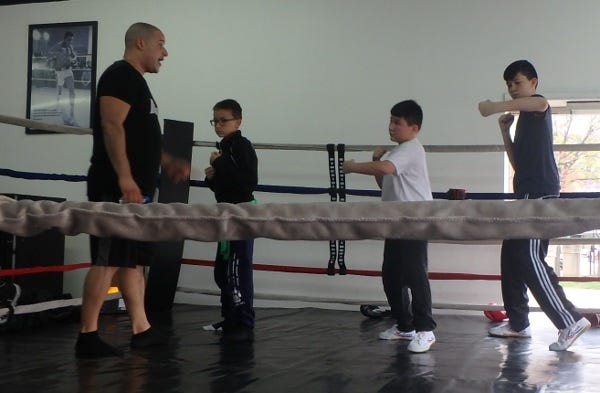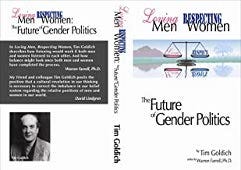David Remnick describes the charisma of Muhammad Ali, “stripped to the waist, a beautiful man, alone, in combat,” and goes on to comment on boxers generally. Compared to basketball or football players, he writes, boxers represent “a more immediate form of super-masculinity, no matter how retrograde” (p. 229). Retrograde means backward-looking, old fashioned. We are supposed to think of boxers as tough guys with big muscles, small brains, and bad grammar. But boxers aren’t backward-looking, although they might seem to be if you are editor of the New Yorker (as Remnick has been for 25 years). What boxers are good at, I say, is looking back.
Remnick signals that he approves of Ali but not of super-masculinity, which is the mark of a man trying too hard to prove his manhood. Remnick’s comment would seem misdirected if applied to Ali, who never doubted himself, even as a child. Insecure he was not. Today you see pictures of Ali in boxing gyms everywhere, and not only because he was a great boxer. He’s there because his masculinity, expressed in his fighting spirit, continues to inspire (Ali in poster, upper left, below).
Boxers have a sensible attitude towards history. They look back to the great boxers they admire and want to imitate. Boxers’ view of history is pragmatic, not academic. They learn from history not only by adopting techniques from great boxers but also by recognizing the corruption and dishonesty that can undercut success in the ring. They also understand that unmanly behavior can drag a great boxer down—Mike Tyson, for example. Boxers know that they need to see the past clearly, without blocking out the parts they don’t like.
Feminists who disapprove of both boxing and masculinity as backward-looking could learn a few things about looking back from boxers. Feminists aren’t very good at looking back. As we see in the writing of anti-feminist historian Janice Fiamengo, they are not good at learning from the past.
Readers interested in feminist and gay-lesbian histories once had at least a limited investment in looking back. Here, for example, is the publisher’s description of History Matters, a 2007 book about feminism by Judith M. Bennett:
“Written for everyone interested in women's and gender history, History Matters reaffirms the importance to feminist theory and activism of long-term historical perspectives. Judith M. Bennett, who has been commenting on developments in women's and gender history since the 1980s, argues that the achievement of a more feminist future relies on a rich, plausible, and well-informed knowledge of the past, and she asks her readers to consider what sorts of feminist history can best advance the struggles of the twenty-first century.”
History mattered in 2007, but only certain “sorts of feminist history” would serve activists. That message was received. Women’s studies courses today, as they appear in online syllabi, are dominated by activist concerns, such as transracial feminism and transnational feminism. It is clear that a vigorous history, a history that does not serve the idealizing ends of feminism, is not needed—if, indeed, history now matters at all.
Feminism, Fiamengo argues, was never about the welfare of women. “The primary impetus of feminism in its early manifestations was to create divisions between men and women, make women angry and resentful, and make men ashamed and depressed.” She continues:
“Feminism was always intended to make women see children as a burden. It was always intended to weaken the family and promote sex without commitment. It was always intended to promote a baseless female supremacism. To that end, it justified infanticide and demonized male authority and male sexual nature.” (“Men Have Been Psychologically Abused by Feminist Ideology For Decades.” August 2022)
Fiamengo has complicated the idea of a heroic feminist past that features oppressed women fighting for their rights. She has shown that important early feminists were misandrists, hardened man-haters. Even some early feminists disapproved of the hostility apparent in the women’s movement. Fiamengo has written about Wilma Miekle, for example, who in Toward a Sane Feminism, published 1917, condemned the movement’s injustices to men. This is not the sort of historical evidence that activists can acknowledge.
Nor do we learn from feminists that, in the same period, some men talked back to feminists, as Tim Goldich points out in Loving Men, Respecting Women: The Future of Gender Politics. The socialist writer Ernest Belfort Bax did so by taking a look back in The Legal Subjection of Men, published in 1908. He demonstrated men’s inequality before the law, a bias he saw emerging in the second half of the nineteenth century.
In 1913 Bax published The Fraud of Feminism. Goldich quotes the preface, in which Bax criticizes the “apostles of feminism.” When presented with evidence that, contrary to the “legend” of their oppression, women were often in the privileged position, these “apostles,” men and women alike, would ignore “what they cannot answer” and try to “stop the spread of the unpleasant truth so dangerous to their cause.” He added, “The pressure put upon publishers and editors by the influential Feminist sisterhood is well known.” There we have it, woke-ism from a century ago. Feminists reading Fiamengo’s work are doing what feminists did in Bax’s time, ignoring what they cannot answer and hoping to “stop the spread of the unpleasant truth.”
There was a similar response when queer theory emerged in the 1980s. Queer theory was groundbreaking because it explored same-sex behavior from what Bruce R. Smith, in Homosexual Desire in Shakespeare’s England, calls an adversarial stance. Queer studies leaped over the patient cultural anthropology of the historians. Indebted to postmodernism and to its themes of fissures, gaps, and contradictions, queer scholars looked for a particular sort of history that focused on transgression as a response to oppression. What it meant to “queer” a text was to show how it had once been—and could still be—a tool of disruption.
The responses to the new histories of sexuality that appeared decades ago were not positive. Claims about gay and lesbian thought from medieval or Renaissance England, for example, met with skepticism. The early writers “could not have meant that,” people would say, where that comprised evidence of same-sex culture that contradicted how the guardians of tradition saw the culture. Some of their objections were transparent attempts to avoid topics that were considered disagreeable because they sullied a familiar past.
Claims about homosexuality in early periods were seen as anachronistic. It was argued that these authors could not have been referring to homosexuality because it did not exist then. It seemed that the topic had been invented in the nineteenth century, along with the word “homosexual,” which was first used in English sources in 1891, according to the Oxford English Dictionary. Yet skeptics could not, in the end, deny that there was evidence of same-sex love (the term I use in Before the Closet: Same-sex Love From “Beowulf” to “Angels in America” [1998]) in earlier periods.
Today the skeptics are feminists who are responding to Fiamengo’s look back. “[Some] feminists simply elect to disbelieve me,” Fiamengo writes, “or to find it unlikely that most feminists thought like that” (i.e., the way she shows they thought). Others who object doubt that “the ones who said the outrageous things really meant what they said.” In other words, the early writers “could not have meant that.” Her critics do not want the “rich, plausible, and well-informed knowledge of the past” that Bennett’s book was supposed to encourage. If they want history at all, it is a history of oppression and the brave women who fought against it.
Feminists feel differently about history when they have a chance to use the past against others, however. Nobody protects a man in office who, let’s say, wrote a foolish essay about sex as a college student. His essay will not be set aside as something he didn’t really mean. Rather, it will be treated as if it had been written yesterday, reacted to with outrage, and used to destroy his career—unless he is a progressive Democrat. In that case, his sin will be hurried out of sight. In 2019 the Democratic governor of Virginia was accused of wearing blackface in a college photograph; months later, a 55-page report said that nobody was sure, after all, who it was in the picture. His lieutenant governor, an African-American, was accused of sexual misbehavior at the same time. Nothing happened. Similar allegations against conservative leaders would never have been treated with such deference.
The reaction to Fiamengo’s work shows the past repeating itself, but with a surprising change. Fiamengo has reversed the epistemological fields of the debate between old and new. Woke feminists now occupy the position once held by traditionalists. Pampered and echoed by the media, today’s feminists hold the power. They express doubts similar to those of traditional scholars who questioned the validity of new sexual histories forty years ago.
Fiamengo, a patient practitioner of traditional historiography, now occupies the adversarial position that was once the sacred ground of feminists and queer theorists. Fiamengo speaks truth to power. She brings up the past that women’s studies has tried to ignore or suppress. Feminists always think that they punch up (going after the strong, i.e., men), which always makes a fighter look good. In 2023, however, feminists are punching down (still going after men, who are now disempowered, and after the few who dissent from feminist dogma), and it makes them look weak. Today Fiamengo and other anti-feminists are the ones who are punching up.
Fiamengo shows that feminist discourse, with its self-regarding virtue, not only rests on a foundation of bigotry and intolerance but also reproduces it. She has upended the upenders. The Fiamengo Files have queered feminism, pointing to its falsehoods, contradictions, gaps, and instability. Fiamengo presents arguments drawn from little-known sources as well as from canonical feminist texts, revealing old expressions of hatred and contempt similar to those that, these days, are found in the tweets of the woke. She holds the mirror of the past up to modern feminists. Here you are, she says; take a look back. It is no surprise that feminists ignore the education Fiamengo offers them. It is no wonder that they fail thank her for her pains.









I'm wondering why it is a given in your piece that feminism and boxing are at odds, and that feminists hate boxing?